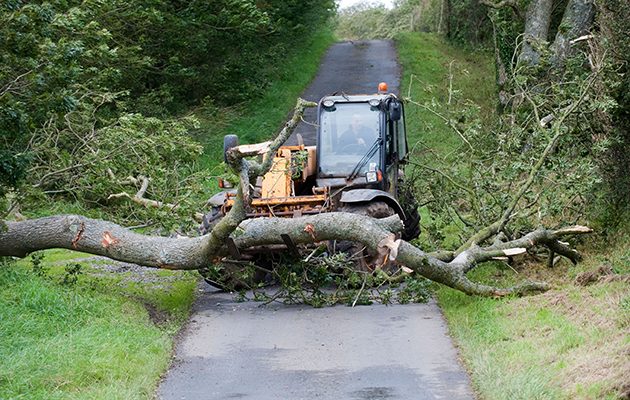Winter is no time to sit back, says Tim Field, as farmers turn their attention to maintenance tasks, ensuring the local lanes run as smoothly as the watercourses
Britain’s farmers caretake an enormous amount of our countryside, and inevitably there comes a time when their resourcefulness and aptitude for engineering comes to the fore. Our farmers acting as engineers is a typical part of the festive period, as Tim Field explains.
For more on farming, read about the typical year of the shepherd in the sheep farmer’s year: from Fawkes to fools.
FARMERS ACTING AS ENGINEERS
A great deal of countryside maintenance is in the hands of Britain’s farmers, who caretake more than two-thirds of our magnificent landmass. Mending fences, hanging gates, installing water troughs, fixing pumps, grading tracks and clearing ditches; without a doubt, farming is best suited to those with an aptitude for engineering. And considering the hectic schedule of the growing season, much of this falls to the short days of winter.
Some farmers make better engineers than others and nothing is more telling than the cowpats and destruction across the village green following a stampede of escapee steers. Multiple generations of baler twine knitting together odds and sods of Rylock wire, rotting stakes and gnarled hedgerow branches are no match for frisky young stock when grass growth has slowed up and the winter pasture gets a bit thin. Bodge-it engineering offers varying effectiveness and comes with regional distinctiveness. My aunt, quite rightly, takes great pride in her take on a “Hampshire gate”: bailer-twine hinges, suspended sheep hurdle and wire latch hooped over a fence post.
Even the immaculate gates and arrow-straight fences of Daylesford don’t always hold back the marauding cattle. After the July 2007 floods, 13 cows were collected several fields downstream as Biblical water levels swept fences aside. But it is the extraordinary ignorance of naïve footpath users that leaves us astounded, as they amble through gates, leave them swinging and ignore the following mob of cattle that ultimately settle into our neighbour’s 100-acre woodland.
The farm engineer’s footprint dates back to the Bronze Age with vast tracks sliced and diced by ancient hedge laying, ditching and stone walling. Whether stone chipping for a drystone wall, a honed billhook tackling an unruly thorn hedge or post driving for wire fencing, these arduous agricultural tasks are generally reserved for the bleakest months, interrupted only to feed and check on stock. It is finger-nipping times, as the damp, cold air strips the sensation from our extremities. A painful compromise is made between chilblains or donning gloves and sacrificing the feel of tools and materials. Once the hard frost retreats, a spontaneous flooding event reveals a burst pipe and now it’s time to grab a spanner and exercise the plumbing skills.
Known for their resourcefulness and favourably large tools, it is inevitable that the local farmer gets a call-up when toppled trees block the road. Up rocks the Hilux, complete with trusty Stihl, trailer and winch. Tree clearing forms part of the seasonal routine, removing obstructive boughs, resurrecting fences and enabling cultivations to get away unimpeded. Stacked and air dried in a sunny field margin, the timber is ready for collection a year later. No farmyard is complete without the log-splitting attachment for the tractor PTO; the timber is processed and sold to fuel the ever-popular cottage log burners.
Once bankside vegetation has died back it is time to attach the ditching bucket and the farmer becomes hydro-engineer. Farmers have a vested interest in maintaining ditches to allow field drains to function and prevent saturation of soils in heavy ground; however, for the frequent times I hear farmer-bashing for not clearing their ditches, it is tempting to applaud obstructed ditches and undredged channels.
Vegetated ditches with ample debris act as micro-dams, slowing water and allowing fine silts and associated nutrient enrichment to settle out of suspension and accumulate – rather than silting up streams and rivers, blocking culverts and prompting flooding in more sensitive and populated areas. There is an extraordinary public misconception that land drainage prevents flooding whereas, in more cases than not, it accelerates flooding, albeit in another location.
Here on the Upper Thames, the River Evenlode Catchment Partnership is undertaking an ambitious, multi-landowner approach to improve the watercourse. This includes the construction of vegetated swales, scrapes and “reconnecting the floodplain” (encouraging a more natural river form, allowing banks to breach and flood non-critical areas). This is all designed to hold water in the upper catchment instead of it racing down to Oxford and reverting the Thames Valley back to swamplands.
There is no time to sit back and relax in the festive days of December, it is prime time to tackle the maintenance “to do” list. While a vocation in engineering is not a prerequisite it certainly helps with the great demands of practical agriculture, whether mechanical, hydrological, structural or environmental.
Follow Tim and Agricology @agricology





